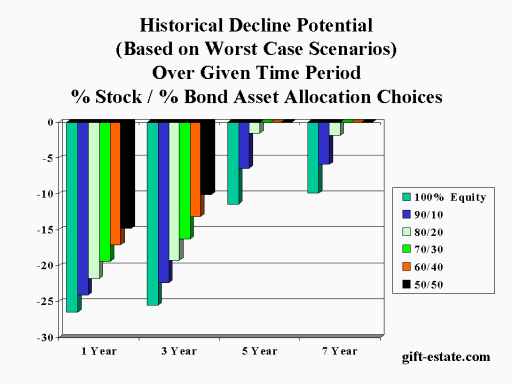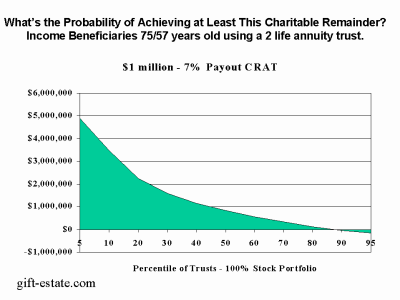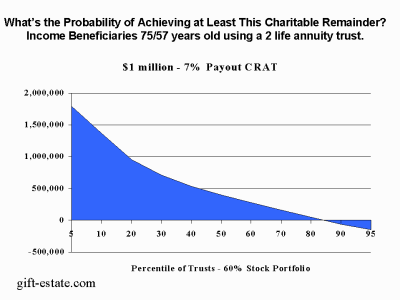When Payouts Won’t Payoff – Henry & Associates
When Payouts Won’t Payoff
Sit down with a prospective client or donor and discuss the benefits of supporting their philanthropic goals with a planned gift. Want to know one of the first questions to pop up if you haven’t done a good job describing charitable mission? “What’s the highest payout we can take from our CRT?” It’s also often one of the most confusing issues that must be addressed after a CRT proposal has been discussed with a client donor. The problem is that those payouts are irrevocably selected and often form the basis for a lot of donor dissatisfaction, so getting the payout just right is important. But, what’s just right? Should it be more than the minimum 5%, or would 8% or 9% be too high? What if your donors find out they could have a 25% payout? Can you explain that 25% might not be a great rate for older clients? How do you respond to their question, “isn’t more income better?” after you’ve just pitched the advantage of a CRT or gift annuity as a way to increase income. If the process is just another transaction comparing interest earned in a certificate of deposit vs. dividends from growth stock vs. the use of a CRT, then you’re already working out of a hole. This is a charitable planning strategy; if there’s not some philanthropic goal, then you’re setting the stage for discontent.
With increased availability of planning software, it’s become more common for donor advisors and their prospective clients to use widely distributed do-it-yourself deduction calculators. When inexperienced planners or clients perform their own calculations, more often than not, they select the highest payout allowed. Is that such a bad deal? One of problems when promoting charitable trusts as tax avoidance tools is that potential client donors never equate their CRT as a charitable gift and many come into the process believing that the charity stands behind a poorly performing CRT, rather than have the trust stand on its own financial merits. If the trust is going to survive and work as proposed, then the design process has to factor in the length of trust term well beyond IRS estimates of mortality, examine various payout rates and project investment performance in both bull and bear markets.
The legal restriction requiring a 10% charitable remainder imposed with §1089 in TRA 1997 and the 5% probability test for a CRAT generally provide an upper practical limit for the payout, and if a client has a choice between a five percent payout and an allowable eleven percent who wouldn’t be confused? It’s not intuitively obvious that a lower payout might generate more income over time, depending on the asset mix of investments held inside the trust and the use of any excess income by the income beneficiary. The problem is that while the feds may set the upper legal limit, planners need to help clients understand the practical risks and how the assets inside the trust will make or break the process.
 Case Study
Case Study
Consider the case study for Richard (75) and Judy (57) McCoy, recently married and looking to minimize capital gains liabilities on the sale of $1 million in stock with a $700,000 basis. They’re planning to fund their CRT but haven’t decided which type of trust or what payout makes the most sense for their needs. Many advisors would look at Rich’s age and suggest a CRAT, but with Judy’s relative youth and an understanding that 50% of beneficiaries live longer than IRS life expectancies, a CRUT is probably the better tool for their needs. Besides offering a chance for increasing income payouts, as opposed to the fixed dollar payments of a CRAT, the CRUT allows for additional contributions to their trust, something the McCoys have mentioned they may do if the trust performs as expected. Given their desire to have a successful trust experience, the selection of payout and the type of investments inside the CRT is very important to both the McCoys and their advisors. Assuming the McCoy’s marginal tax rate of 38% for federal, state and city tax and 23% for capital gains tax stays static, they’d prefer to maximize the tier two income from the trust, especially when they’re contributing an appreciated asset. (see table at end of article)
The CRUT is a two-edged sword, because it offers an opportunity for the income distributions to ride along up with increasing trust performance, but it also can slide downhill when the trust declines in value. A lot of trustees learned their lesson the hard way when they contributed dot-com stocks last year and figured they’d ride them up to stratospheric levels. If one of the purposes for creating the trust was to lock in a profit and diversify the portfolio, it doesn’t take many drops like those seen in high technology companies to make hindsight appear to be 20/20. Factor in the low interest rate environment within many of the fixed income instruments and trustees or their advisors have to sort through some serious issues if they expect to keep everyone happy in the process.
Market volatility can be a real problem for a CRT, and when the four tier accounting system is factored into the payouts, it may not be clear to many advisors what payout and asset allocation mix best works inside these §664 trusts. There are rules of thumb that should kept in mind when discussing the use of a CRT. But at the heart of every charitable trust is the concept of the “split-interest” vehicle and its two beneficiaries. With two sides to an equation, there will be competing interests that must be addressed. When charities act as trustees and investment managers, they often bring an institutional mindset that’s inappropriate for managing a CRT or CLT. What works for an endowment fund managed by a charity where 100% of the income earned is untaxed isn’t the same for a charitable trust. The charity, as a remainder beneficiary, wants a significant gift, and sooner is better than later. An income beneficiary (usually the donor) of a CRT wants to receive more income that’s tax efficient, and that can be produced by three primary methods:
- Invest in an appreciating equity portfolio, avoid dividend paying stock and sell assets to meet the required payouts that will mostly be tier two distributions taxed at lower rates. Charities that have been managing their charitable trusts like endowment funds or pension accounts do not produce tax efficient returns because they try to invest too conservatively to preserve capital, and they often produce mostly tier one income taxed at ordinary rates. For a tax-exempt institution, that’s not an issue, but downstream to a tax paying income beneficiary, it’s a critical problem. Without having some equity component to their portfolio, the institutional investors won’t be in a position to grow the value of the trust greater than the rate of inflation. Factor in inflation and trust expenses, and if the trust has any expectation of growth, significant equity ownership is necessary. The problem is that with increased stock ownership comes increased volatility and risk.
- Invest in tax-free municipals if the trust was funded with cash or high basis assets and maximize the tier three income distributions that are tax-free to the income beneficiary. However, in today’s low interest environment, it’s not going to produce an increasing income stream in a CRUT and is likely to cause the CRAT to collapse when the principal is consumed. The income beneficiary may like those tax efficient fixed payouts of tier three or tier four return of principal, but the charity is bound to suffer as the trust corpus is eroded by inflation and disappearing capital.
- Be unlucky (reference hypothetical analysis) and be in the market at the wrong time or manage the money imprudently by using assets that don’t produce much income and haven’t appreciated yet, producing distributions that are mostly tier two capital gains or tier four principal. Surprisingly, this strategy works pretty well in the short-term for a CRAT, clear up until the trust implodes and collapses with nothing left for the charity. As long as it doesn’t happen prior to the income beneficiary dying, there are planners who create charitable trusts who view this as a great strategy. The donor receives a deduction for an improbable gift to charity and has stripped out as much of the income as possible, paying little or no tax over the term of the trust. Of course, this can happen with the best of intentions in a market like that found in the year long hiccup that started March 10, 2000 when the NASDAQ Composite Index reached an all-time closing high of 5,049 and by March 9, 2001 the average closed at 2,053, a decline of nearly 60%.
Not just remainder trusts are affected
These tax efficient investment decisions aren’t just a problem for remainder trusts, the lead trust has its problems too. In a CLT, a tax paying lead trust, the taxable income is offset by the charitable distributions in the classic non-grantor non-reversionary CLAT. While it might not be a big problem initially, as the portfolio continues to appreciate inside the trust, accommodating a 3% ordinary income rate for dividends and interest earned and a 7% capital appreciation becomes more difficult as the trust doubles or triples in size. In a 5% CLAT, it might not be difficult to initially absorb 3% dividend earnings through distributions and trust expenses, but as the trust grows in size the static charitable distributions don’t wash out the growing earnings from a well managed and rapidly growing portfolio. This becomes a serious problem in lead annuity trusts with terms greater than seven or eight years; it’s less of a problem in the CLUT.
 “Happiness through pessimism”
“Happiness through pessimism”
(or don’t oversell market expectations)
Markets move in cycles and understanding market volatility is important if both of the beneficiaries are going to be satisfied with the trust’s operation, and that’s part of the problem there are two potentially adversarial parties to the management of the CRT. When a prospective client-donor asks an advisor to design a CRT so they can strip out as much income as possible, leaving the charity with little or nothing, then maybe the use of a CRT should be rethought. Too many people have been sold on the concept of a win-win-win scenario when using a CRT to escape the capital gains hit when selling stock, but they forget that there is a real cost to the donor when giving away an asset through an irrevocable trust. If there’s no pressure to sell an asset immediately, then sometimes it makes more sense to sell a little stock annually to meet needs for income, and if there’s a capital gains liability, there would be a tax on the distribution from the CRT at either tier one or tier two tax rates too. It could be argued successfully that for many clients, they’re better off not using a CRT if tax avoidance is their primary motivation. If the support of charitable mission is the goal, then planned gifts through charitable trusts may be the answer.
 What If?
What If?
To better understand the reality of a CRUT’s performance, imagine that one of your clients established a CRUT with $1 million in March of 1969. That year was significant because it was when §664 trusts were first codified under current law, and this new tool was about to experience the double whammy of inflation and stagnant market performance. Historical returns don’t predict future performance, but they can sure give you an idea of how badly things can fall apart when the conditions are just right. If we’ve learned anything about markets, caution dictates watching for trends that might show up again.
One of the reasons planners like to use a CRUT is that it has the potential to increase the payouts over time and offset inflationary pressures. What too many gift planners fail to disclose to their prospective donors is the very real chance that the income beneficiaries may have a drop in their payout if their trust assets decline in value.
Given the market volatility in 2000, many charitable trusts took a significant hit when the Dow Jones Industrial average of 11,357.51dropped 5% by year’s end to 10,786.85. Add in an S&P 100 that was down 13.42%, the NASDAQ Composite that fell 39%, the Dow Jones Internet Index down 66%, and performance like that has significant potential to prevent the trust from working as illustrated. Even a modest 7% payout trust has the potential to blow up when the market goes into a free-fall.
Although uni-trusts tend to not be as adversely affected as a higher payout CRAT, as the payouts aren’t so rigidly structured in absolute amounts, but even annuity trusts have potential problems. If pushed, a 10% payout CRAT, that meets legal requirements for a 10% remainder when established, may implode if there are a couple of years of sub-par performance. As a rule of thumb, avoid payouts higher than the §7520 Applicable Federal Rate (AFR), or there’s a chance that the trust will run out of principal before the term of the trust expires, leaving both the income beneficiary and remainder charity with nothing. For uni-trusts, consider limiting payout for lifetime calculations to three or four percentage points under conservative expectations for average investment performance. Extra care needs to be taken with any CRT that has a payout greater than 6.5%. If the unitrust is a net income model, it’s possible that several years will pass by with no income distributions. Is the advisor willing to sit down with the trustee and income beneficiary and explore what happens if the trust can’t payout any income? If the beneficiary can’t comfortably forego income for three to five years, then a NIMCRUT or NICRUT may be a bad choice. Should the asset be one that’s hard to value, then a FLIP CRUT should be considered, but if the asset isn’t likely to sell quickly, then the advisor should counsel caution or delay the CRT formation until income security can be more easily assured.
 Many states have adopted the Prudent Investor Rule that mandates a total return investment philosophy. Theoretically, both the income and remainder beneficiaries gain through investment performance under this approach. Besides taking a more balanced view of trust investments, losses due to inflation and management fees should also be addressed when creating an investment philosophy. For example, an eight percent payout in a CRAT, with a typical management fee for investments and trust expenses of 1.5% and 3% for inflation, needs to have a return of 12.5% just to tread water. Given the historical returns in the market, few trustees would feel comfortable seeking a portfolio that had to average 12.5% without also accepting increased volatility and risk. One of the important discussion points for investment professionals is to ask trustee how likely they will see a return that must earn 12%+ in any long term market. Advisors must establish how much more risk trustees are willing to take to achieve above average gains compared to historical returns. If the trustee can be shown clear statistical models that a slightly conservative approach is likely to be more effective, then properly setting the payouts might help achieve long term trust strength.
Many states have adopted the Prudent Investor Rule that mandates a total return investment philosophy. Theoretically, both the income and remainder beneficiaries gain through investment performance under this approach. Besides taking a more balanced view of trust investments, losses due to inflation and management fees should also be addressed when creating an investment philosophy. For example, an eight percent payout in a CRAT, with a typical management fee for investments and trust expenses of 1.5% and 3% for inflation, needs to have a return of 12.5% just to tread water. Given the historical returns in the market, few trustees would feel comfortable seeking a portfolio that had to average 12.5% without also accepting increased volatility and risk. One of the important discussion points for investment professionals is to ask trustee how likely they will see a return that must earn 12%+ in any long term market. Advisors must establish how much more risk trustees are willing to take to achieve above average gains compared to historical returns. If the trustee can be shown clear statistical models that a slightly conservative approach is likely to be more effective, then properly setting the payouts might help achieve long term trust strength.
 CRATS Aren’t As Safe As You Think
CRATS Aren’t As Safe As You Think
When a donor puts $1 million into a CRAT with the intention that at the end of the term there will be a $1 million gift to charity he/she needs to remember that that gift will be devalued by inflation over time. Serious consideration should be given to creating a trust that withstands the volatility in the market if a gift is expected to be meaningful. Institutions investing to preserve principal too often sacrifice investment potential that will ultimately hurt the charity in a CRAT, and may harm both the income and remainder beneficiaries in a CRUT.
Many advisors gloss over the risks of declining market performance because recent bull markets have been consistently outperforming their historical returns and market corrections have been uncharacteristically short lived. In a bull market, everyone is an expert investor, but when things head south, there are serious problems investing with news magazines and pundits as financial advisors. Consider what happens when a $1 million CRAT is funded in early 2000 and invests in a supposedly “safe” NASDAQ Index type fund that dropped 39% that first year. If the trustee gets cold feet and repositions the balance in a fund that nets a respectable 7% after trust expenses, what can the trustee expect will happen in a legally established 7% CRAT. Surprising few advisors, the overstressed trust still collapses. It seems like everyone assumes a CRAT is the most conservative planning tool if preservation of capital is the goal, but if the trustee errs in early years, it may be a death knell for the trust over time. Given the same fact pattern with a 6% CRAT, the trust still runs out of assets after 20 years and in the 5% CRAT, which is the lowest payout allowed, distributions eat into principal in the 21st year and the CRAT collapses after 30 years.
Can you say “malpractice”?
or how to avoid using your E&O; coverage
Of concern to both commercial and nonprofit gift planners is the potential for donor dissatisfaction. Providing advice when establishing deferred gifts sometimes comes back to haunt professionals when their clients have to face an unexpected downturn. Besides the well-known consumer complaints about under performing universal life insurance policies, there are similar complaints about pooled income funds that were pitched as great retirement income tools. Add to that unhappy mix a population of income beneficiaries of CRAT and CRUT gifts that have been invested poorly and a litigator with an understanding of fiduciary accounting or investment management, and you will have a bunch of advisors and charities soon ducking for cover. What has been a common thread in telephone conference calls with client donors this last year? Consider the following comments from irate charitable trust creators.
- “How could my CRAT run out of money? I was told it was guaranteed for life.”
- “I need to pay insurance premiums for my wealth replacement trust and my net income CRT was supposed to provide liquidity after I sold my property. The trustee hasn’t been able to unload my real estate and I don’t have any income.”
- “I didn’t know my CRUT would produce declining income payments, the illustrations showed increasing annual payments.”
- “Why can’t I get income out of my NIMCRUT? I thought that a spigot trust could always access that make-up account.”
- “Why do I have to pay tax on my income distributions at 39.6% when I funded my trust with cash and appreciated property?”
- “I have an annuity funded NIMCRUT and with last year’s 30% decline in my portfolio I was just told not to expect an income distribution for two or three years. I’m damn mad; where’s my lawyer?”
 Investment and trust management require infrastructure support and this cost is often overlooked as a drain on the investments. Add to that even a modest cushion for inflation, and it’s reasonable to suggest that if an increasing payout is to occur the CRUT payout must be well below the expected rate of return. For example, if an equity based portfolio is projected to return ten percent, then a CRUT probably should not payout more than five or six percent annually, even if the maximum allowable payout is over nine percent. Short-term perspective when selecting higher payouts may mean the eventual income distributions will be compromised over time as the trust corpus is reduced.
Investment and trust management require infrastructure support and this cost is often overlooked as a drain on the investments. Add to that even a modest cushion for inflation, and it’s reasonable to suggest that if an increasing payout is to occur the CRUT payout must be well below the expected rate of return. For example, if an equity based portfolio is projected to return ten percent, then a CRUT probably should not payout more than five or six percent annually, even if the maximum allowable payout is over nine percent. Short-term perspective when selecting higher payouts may mean the eventual income distributions will be compromised over time as the trust corpus is reduced.
Historical Decline Potential (Based on Worst Case Scenarios on a calendar year basis) Over Given Time Period Stock/Bond Asset Allocation Choices
Data from a diversified portfolio, using the statistical performance of the S&P 500, Russell, Lehman and EAFE indices for large cap, small cap, bonds and international investments.
When a client donor sits down with an advisor to select the payout and investments used inside a charitable trust, it makes sense to look at the historical performance of the market and see how the trust would have performed in the past. By overlaying the predictions with real world data, risks can be better assessed. This approach grounds the projections in reality and replaces predictions in the illustrated proposals with something the trustee can better understand.
For example, just how likely is it that a portfolio will generate a 10% rate of return? What happens to trust performance if the asset mix is skewed towards equities, compared to bonds? What if there’s only a 5 percent probability that the trust will appreciate? Perhaps a different asset mix or a lower payout should be used, and understanding something about the statistics will help advisors and trustees make better choices. When reviewing probabilities of success, consider the 7% CRAT illustrated below. If this trust was invested in a portfolio containing 100% equities and 0% fixed income instruments, a trust found in the 5th percentile is expected to produce a remainder value for charity of $3.186 million or more. However 95% of trusts managed the same way are expected to perform worse than that, so it’s inappropriate to suggest that this particular CRAT will meet all the donor’s goals. Advisors who fail to realistically manage client expectations are the most at risk for dissatisfaction when the trust underperforms. If illustrations depend on 5th percentile performance to succeed, then it should come as no surprise that everyone involved in the trust will be unhappy. Warning flags should immediately go up if the 50 percentile group contains trusts with a portfolio asset mix that collapses before life expectancy, then the trustee isn’t properly looking after the income beneficiary or the charity’s needs.
What Mix of Assets Works Best and How Much Risk is Inherent in Those Choices?
 |
 |
 |
 |
What’s all this mean?
The following table explores the probability of CRT success with various equity and bond asset mixes in the trust, then it factors in inflation and the after-tax income distributions under a four tier accounting system and estimates what the charity will receive when the trust terminates. What can you take away from this table?
- More equity ownership generally increases volatility.
- More equity ownership increases the probability that the trust will appreciate over time and distribute more tier two income.
- More bond ownership generally lessens volatility but increases tier one income payouts.
- More bond ownership in the portfolio generally limits growth of the trust corpus.
- A CRT survives based on its own performance. If the principal is lost, the trust collapses and leaves nothing for charity or the income beneficiary.
- Poorly managed trusts may, for a short time, produce income distributions that are attractive to the income beneficiary because of the tiered payouts. However, invading principal often dooms the trust’s performance.
- Markets go up and down, don’t plan on static market performance when illustrating what happens inside trusts that are expected to last many years.
- Even in a well managed and tax-efficient CRT, some ordinary income is likely to be produced. Make sure the trustee has the ability to pay trust expenses (tax return preparation, state compliance expenses, trustee fees, legal and investment advice, etc.) from tier one income so that income distributions might more readily be drawn from tier two income.
Probability of after tax annual distributions to the income beneficiary in McCoy case study.
| CRT
Payout
Rate
(%) |
Type
CRT |
Probability
of Meeting
or Exceeding
Projections |
Avg. Payout
(after tax)
100% stock
0% bond |
Charitable
Remainder
100% stock
0% bond |
Avg. Payout
(after tax)
80% stock
20% bond |
Charitable
Remainder
80% stock
20% bond |
Avg. Payout
(after tax)
60%stock
40% bond |
Charitable
Remainder
60% stock
40% bond |
|
CRUT |
5% |
$74,897 |
$3,186,132 |
$59,752 |
$2,239,004 |
$48,349 |
$1,584,425 |
|
CRUT |
50% |
$43,512 |
$1,025,787 |
$39,177 |
$882,342 |
$35,282 |
$757,654 |
|
CRUT |
95% |
$28,611 |
$330,256 |
$29,894 |
$427,138 |
$27,135 |
$362,300 |
|
CRUT |
5% |
$77,604 |
$1,912,001 |
$63,219 |
$1,343,628 |
$52,208 |
$950,815 |
|
CRUT |
50% |
$46,298 |
$615,576 |
$42,264 |
$529,494 |
$38,602 |
$454,669 |
|
CRUT |
95% |
$30,958 |
$198,187 |
$30,504 |
$208,662 |
$29,934 |
$217,417 |
|
CRUT |
5% |
$75,691 |
$1,134,725 |
$62,848 |
$797,410 |
$52,876 |
$564,285 |
|
CRUT |
50% |
$46,885 |
$365,329 |
$43,271 |
$314,242 |
$39,961 |
$269,835 |
|
CRUT |
95% |
$32,725 |
$117,619 |
$32,301 |
$123,836 |
$31,787 |
$129,031 |
| 11 |
CRUT |
5% |
$71,692 |
$665,668 |
$60,619 |
$467,787 |
$51,900 |
$331,028 |
| 11 |
CRUT |
50% |
$46,314 |
$214,314 |
$43,144 |
$184,345 |
$40,218 |
$158,294 |
| 11 |
CRUT |
95% |
$34,264 |
$68,999 |
$33,947 |
$72,646 |
$33,544 |
$75,694 |
| CRT
Payout
Rate
(%) |
Type
CRT |
Probability
of Meeting
or Exceeding
Projections |
Avg. Payout
(after tax) 2, 3
100% stock
0% bond |
Charitable
Remainder
100% stock
0% bond |
Avg. Payout
(after tax) 2, 3
80%stock
20% bond |
Charitable
Remainder
80% stock
20% bond |
Avg. Payout
(after tax) 2, 3
60%stock
40% bond |
Charitable
Remainder
60% stock
40% bond |
|
CRAT |
5% |
$34,112 |
$6,611,248 |
$32,081 |
$4,349,850 |
$31,155 |
$2,834,399 |
|
CRAT |
50% |
$35,043 |
$1,592,407 |
$33,220 |
$1,285,380 |
$31,785 |
$1,024,149 |
|
CRAT |
95% |
$35,442 |
$193,797 |
$34,355 |
$224,592 |
$33,219 |
$250,632 |
|
CRAT |
5% |
$42,965 |
$4,891,019 |
$40,634 |
$3,022,546 |
$39,475 |
$1,797,632 |
|
CRAT |
50% |
$43,763 |
$824,130 |
$42,447 |
$590,799 |
$41,416 |
$395,887 |
|
CRAT |
95% |
$48,032 |
-$181,106 |
$47,039 |
-$161,906 |
$46,051 |
-$145,435 |
|
CRAT |
5% |
$51,728 |
$3,170,789 |
$50,016 |
$1,695,242 |
$49,283 |
$760,865 |
|
CRAT |
50% |
$53,125 |
$55,852 |
$54,158 |
-$103,782 |
$55,224 |
-$232,375 |
|
CRAT |
95% |
$61,857 |
-$556,009 |
$61,396 |
-$548,404 |
$60,930 |
-$541,503 |
Table is based on an annual inflation rate of 3% with 1.5% investment and trust management fees in portfolio with varying asset mixes. The investment returns are based on historical (*) market returns and should not be used to guarantee future performance.
For a comparison of 1969 – 1983 S&P; 500 Index, Dow Jones Industrials and 1 Year Treasuries, the following link used for some of the research may be useful.
The income and remainder numbers have been factored to show the values with inflation and trust/investment administration expenses, e.g., if a charity is projected to receive $500,000 in 23 years, it’s present day value of $253,346 (based on a 3% inflation rate) is displayed in the table.
The charitable remainders may illustrate a negative number if trust corpus is eroded. In actuality, a CRT would collapse and discontinue payouts once all principal is consumed, but the scale of the negative number shows how poorly a trust might perform if allowed to free fall. It is noteworthy that in an eroding CRT, an income payout may be more tax favored because any tier two and tier four payouts mean that the income beneficiary has a higher effective “spendable income”.
When software calculations show an invasion of principal is a statistically likely event, much of the distribution amount will result in increased “spendable income” from tier four principal. These payout numbers should be assumed to be the average distribution only for the years the trust exists.
Statistical analysis courtesy of Swerdlin-White – Bank of New York Probability Software
Gift and Estate Planning Services
 CONTACT US FOR A FREE PRELIMINARY CASE STUDY
CONTACT US FOR A FREE PRELIMINARY CASE STUDY
FOR YOUR OWN CRT SCENARIO or try your own at Donor Direct. Please note — there’s much more to estate and charitable planning than simply running software calculations, but it does give you a chance to see how the calculations affect some of the design considerations. This is not “do it yourself brain surgery”. When is a CRUT superior to a CRAT? Which type of CRT is best used with which assets? Although it may be counter-intuitive, sometimes a lower payout CRUT makes more sense and pays more total income to beneficiaries. Why? When to use a CLUT vs. CLAT and the traps in each lead trust. Which tools work best in which planning scenarios? Check with our office for solutions to this alphabet soup of planned giving tools.
4/11/2001
 In this world nothing can be said to be certain, except death and taxes – Benjamin Franklin
In this world nothing can be said to be certain, except death and taxes – Benjamin Franklin










 Case Study
Case Study “Happiness through pessimism”
“Happiness through pessimism” What If?
What If? Many states have adopted the Prudent Investor Rule that mandates a total return investment philosophy. Theoretically, both the income and remainder beneficiaries gain through investment performance under this approach. Besides taking a more balanced view of trust investments, losses due to inflation and management fees should also be addressed when creating an investment philosophy. For example, an eight percent payout in a CRAT, with a typical management fee for investments and trust expenses of 1.5% and 3% for inflation, needs to have a return of 12.5% just to tread water. Given the historical returns in the market, few trustees would feel comfortable seeking a portfolio that had to average 12.5% without also accepting increased volatility and risk. One of the important discussion points for investment professionals is to ask trustee how likely they will see a return that must earn 12%+ in any long term market. Advisors must establish how much more risk trustees are willing to take to achieve above average gains compared to historical returns. If the trustee can be shown clear statistical models that a slightly conservative approach is likely to be more effective, then properly setting the payouts might help achieve long term trust strength.
Many states have adopted the Prudent Investor Rule that mandates a total return investment philosophy. Theoretically, both the income and remainder beneficiaries gain through investment performance under this approach. Besides taking a more balanced view of trust investments, losses due to inflation and management fees should also be addressed when creating an investment philosophy. For example, an eight percent payout in a CRAT, with a typical management fee for investments and trust expenses of 1.5% and 3% for inflation, needs to have a return of 12.5% just to tread water. Given the historical returns in the market, few trustees would feel comfortable seeking a portfolio that had to average 12.5% without also accepting increased volatility and risk. One of the important discussion points for investment professionals is to ask trustee how likely they will see a return that must earn 12%+ in any long term market. Advisors must establish how much more risk trustees are willing to take to achieve above average gains compared to historical returns. If the trustee can be shown clear statistical models that a slightly conservative approach is likely to be more effective, then properly setting the payouts might help achieve long term trust strength. CRATS Aren’t As Safe As You Think
CRATS Aren’t As Safe As You Think Investment and trust management require infrastructure support and this cost is often overlooked as a drain on the investments. Add to that even a modest cushion for inflation, and it’s reasonable to suggest that if an increasing payout is to occur the CRUT payout must be well below the expected rate of return. For example, if an equity based portfolio is projected to return ten percent, then a CRUT probably should not payout more than five or six percent annually, even if the maximum allowable payout is over nine percent. Short-term perspective when selecting higher payouts may mean the eventual income distributions will be compromised over time as the trust corpus is reduced.
Investment and trust management require infrastructure support and this cost is often overlooked as a drain on the investments. Add to that even a modest cushion for inflation, and it’s reasonable to suggest that if an increasing payout is to occur the CRUT payout must be well below the expected rate of return. For example, if an equity based portfolio is projected to return ten percent, then a CRUT probably should not payout more than five or six percent annually, even if the maximum allowable payout is over nine percent. Short-term perspective when selecting higher payouts may mean the eventual income distributions will be compromised over time as the trust corpus is reduced.









